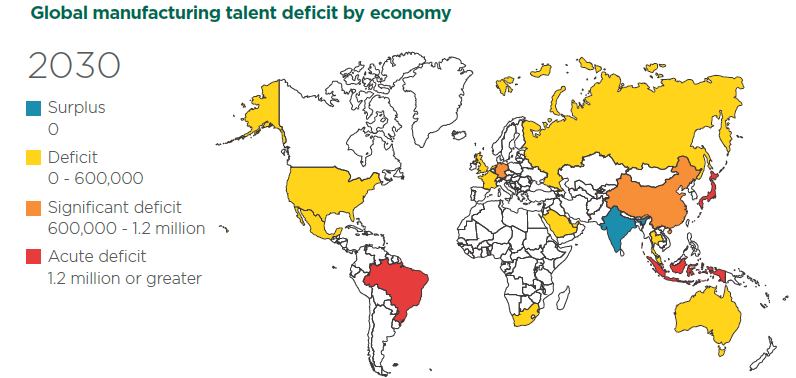If nothing else, 2020 has shown that learning new digital tools and technologies is important for everyone. The world has been accelerated into new ways of thinking and doing things. People have discovered that they can learn new skills which, at the start of the year, they had never even thought about. This puts businesses in a different situation when it comes to training and upskilling staff. Like so many other business functions, the HR and IT departments need to re-examine their goals and strategies for training, talent management and succession planning.
Various reports and surveys in the last few years have discussed the problem of skills shortages and how quickly relevant skills can become irrelevant:
- In a recent Deloitte survey, 51% of CIOs said there was a significant mismatch between current competencies and future needs.
- In 2017, a CapGemini/LinkedIn report commented that 54% of the respondents in their survey agreed that the digital talent gap was hampering digital transformation and that their organization has lost competitive advantage because of a skills shortage
The challenge of the technology talent gap is no longer just an HR issue; it is an organization-wide phenomenon. Traditional training and talent development practices will not be enough. To solve the expected talent limitations, the future of work requires more intelligent, agile and adaptable learning paths. For organizations that have invested a lot of time and money in getting their technology systems (e.g. ERP) working, this is an important aspect in safeguarding that investment. The fact that businesses have found they can implement digital transformation projects in weeks, rather than months or years, due to the pandemic, shows that training in new tools and technologies is critical.
The skills gap in manufacturing
A report in 2018 by Korn Ferry, a consulting firm that focuses on organizational structures and roles, forecast that:
“By 2030, demand for skilled workers will outstrip supply, resulting in a global talent shortage.”
Manufacturers could face a global labor shortage of 7.9 million workers by 2030.
The surge in unemployment caused by the pandemic of 2020 is unlikely to have mitigated the shortage much as skilled workers are likely to find jobs more easily.

(Source: Korn Ferry – The Global Talent Crunch)
As manufacturers increasingly turn to automation and other advanced technologies, the demand for people who can innovate, create, manage, and apply new technologies will grow beyond the available supply. Without these types of skills, executives will find that digital transformation becomes that much harder.
New strategies for talent management and development
For many companies, learning is still rooted in 20th-century practices. It hasn’t just been WFH and remote working that has changed training, it was already happening, except now the change has accelerated.
The evolution of training | |
| From | To |
| Classroom | Anywhere, anytime |
| Comprehensive, mass-produced | Targeted, customized |
| Lecture | Digital, interactive, experience-based |
| Instructor-led | Peer-led |
What organizations should provide |
| Cultivate a culture of curiosity |
| Provide good reasons for change |
| Set business objective with clear goals |
| Employees are accountable for achieving goals |
| Provide tools, resources, support |
| Ensure employees have time to learn |
| See mistakes as learning lessons, not failures |
(Source: Harvard Business Review, 2019 – IT Talent Strategy: New Tactics for a new era)
The pressure to re-consider training practices comes not only from increased automation and other digital changes. If training is not available to staff, employees become disenchanted, especially the ones you want to keep. The CapGemini/LinkedIn report showed that many employees are getting frustrated with in-house training, or indeed are worried that it won’t provide the skills they will need. So they are turning to outside education sources, and would even move to another employer if that improves their skills.
To develop an environment that values training and upskilling, businesses need to undertake the same kind of project steps they would do for other major transitions.
To summarize what several studies recommend:
- Create a vision and mission – develop a talent strategy that aligns with business goals.
- Define new roles and capabilities that the business will need for its future direction and growth. This will assist HR to know if new skills are becoming critical for existing roles.
- Create a workplace culture that promotes key competencies such as learning agility, collaboration, adaptability.
- Focus on hiring and talent development on how well people learn and adapt.
- Build and promote a brand that attracts people with a passion for learning
What business needs from training
When it comes to what a business needs from training its staff, there are some top-of-mind considerations that an upgraded learning and development (L&D) approach should address.
– Productivity
– Agility
– Upskilling
Data from a survey of over 500 organizations provide answers.
| Goal | Pacesetter organizations | Other organizations |
| Upskilling has enabled us to be nimble, and move to new roles | 75% | 57% |
| Using a new L&D approach, we have seen an improvement in productivity | 86% | 66% |
(Source: CapGemini/LinkedIn, 2017 – The digital talent gap)
What HR needs
HR departments in this new era of change may need help in the areas of training course selection, talent management and identification, and succession planning.
In terms of courses, they should look at solutions that:
- offer accessible, off-the-shelf skills development
- are role-based
- can integrate with an existing skills development program
- allow staff to personalize aspects of training
- are online; making training available anytime, anywhere, and in small enough chunks so that employees can fit training into their schedule
- can also be delivered onsite by trainers with the skills to understand an organization’s unique requirements, and who can not only customize training but help provide online guides
- allow you to administer, measure and monitor the progress of each user
- are cost-effective
Talent management comes down to two things: how to attract talent to work for your organization, and how to keep it. Succession planning then ensures talent is developed so that there are employees with the competence to fill vacant leadership and other positions.
| Attract talent | Retain talent | Develop talent | |||
| Leadership supports the needs for a digital talent strategy | Diversify recruitment approach | Provide flexible and collaborative ways of working | Give talent the power to implement change | Create an environment that prioritizes and rewards learning | Chart a clear career development path |
(Source: CapGemini/LinkedIn)
HR and training need to adapt to the new world of work
Microsoft CEO Satya Nadella has been quoted as saying that he would much rather have a company full of learn-it-alls than know-it-alls. That’s why learning in the corporate environment needs to change from being an enforced practice to one that awakens people’s curiosity.
It’s been known for a while that technology cannot deliver its promised gains if there are not enough human workers with the right skills. Having the right digital skills, capabilities, and mindsets is going to be critical. For the foreseeable future, organizations are going to need modern, intelligent, agile, and adaptive learning systems to align and assess talent potential and reskill employees. Given the rapid changes that the world is seeing, it may well be that the most valuable employees aren’t those who know the most, but those who learn the best.






